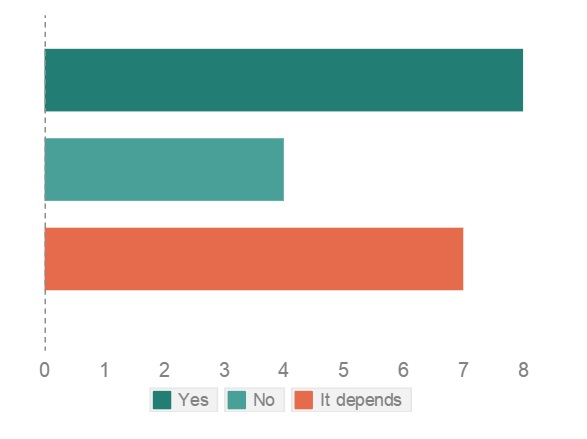by Venchito Tampon Jr | Last Updated on October 24, 2021
It has been an intriguing discussion in the SEO community when John Mueller (Google Webmaster Trends Analyst) answered this question:
If the majority of the links become the quality links, would this help a person to remove or would Google robot remove the Penguin penalty?
His answer was straightforward, “That would definitely help. Yeah.”
More information on the Q&A portion here: https://www.seroundtable.com/google-disavow-good-links-penguin-19696.html
Moving forward, last week I asked 19 SEO experts to answer this specific/similar question:
Can good links alone get you out of a Penguin penalty even without disavowing the bad links?
The answers are listed below but to give you a short statistics. Here is what I’ve found out.
So without further ado, let’s hear what SEO experts say on this topic:
Eric Enge, CEO of Stone Temple Consulting 
Google’s John Mueller confirmed on January 12th of this year that getting good links can get you out of a Penguin penalty. He did that in one of his Office Hours hangouts. You can read the write up from Barry Schwartz here: https://www.seroundtable.com/google-disavow-good-links-penguin-19696.html
That said, what you don’t know, is how many good links you need to get. If you have been hit by Penguin, it would remain my advice to go through a link cleanup, removal, and disavow process. This will pretty much always speed up the process, and when you have been hit by Penguin you always feel the need is urgent.
On the flip side, I would also never simply to the link cleanup/removal/disavow either. You always want to be earning good, high quality links.
Dan Petrovic, Director of DejanSEO 
This is a dangerous statement, taken out of context of what has actually been said. Penguin is not an on and off algorithm and as such has a gradient of impact. This means that a marginally affected website can overpower the negative effect if it just minds its own business and keeps on a whitehat path. That said, why would you do that? If you’re in the business of optimisation you’d want to be responsible and actually optimise the situation by minimising the negative impact of the algorithm through disavowing all known toxic links. So in short, yes in some cases but you’d be silly not to take proactive approach to shorten or minimise the impact.
Cyrus Shepard, Senior Content Astronaut at Moz
Can webmasters escape Penguin jail without having to use the disavow tool? Yes, I believe not only can they, but in many instances they actually do.
Google representatives have made comments recently to indicate that Penguin works by examining ratios between good links and those deemed manipulative. While this is likely an over-simplified explanation, it makes total sense. Sites like Amazon, by their very nature, have a huge number of “unnatural” links in their profile, but these are potentially dwarfed by the number of good links that helps prevent most Penguin actions.
So the goal of the webmaster faced with solving Penguin is to improve the ratio of good links to bad. Using the disavow tool is one quick option, but one that also risks thowing out good links with the bad. An optimized strategy would also include considering a few of the following strategies to improve your link ratio:
- Build more good links
- Remove bad links through manual outreach
- Do nothing, let bad links atrophy and disappear (takes a long time and is lazy, but I’ve seen it work in some cases)
In fact, Google itself recommends using the disavow as a tool of last resort, and there are many viable alternatives that may actually work better.
Richard Baxter, CEO of Builtvisible
Honestly, I don’t think so. You’d have to increase the links to a domain an order of magnitude higher that whatever the current level (theoretically) is. Even then, I don’t know because if it’s a manual intervention surely it wouldn’t be enough. Maybe if it was algorithmic in nature. Like I said, I wouldn’t be too sure and I wouldn’t want to risk the wait.
That’s why it’s smart to address a penalty and put *all* of your marketing energy into the link removal (I much prefer link removal as the primary solution) and Disavow (if the bad links can’t be removed).
Larry Kim, CTO of Wordstream 
Yes! Spammy links are measured on a relative basis not an absolute basis. Meaning, it has to do with the mix of good vs. garbage links pointing to your site, rather than just the absolute number of junk links. For example, a site like the NYTimes might have millions of junk links (from scraper sites, etc.) but have hundreds of millions of high value editorial links, so no penalty despite potentially having a high number of junk links. Thus it is often a much easier and scalable strategy for companies – especially companies who have an established brand, to pursue higher value links rather than attempt the seemingly impossible task of removing a large volume of links from sites you don’t control, or reviewing a link profile of millions of links and manually disavowing the junk links.
James Norquay, Director of Prosperity Media 
Firstly you need to make a clear difference between Manual penalties and algorithmic action as they work differently. You are not going to get out of a “Manual Penalty” with only good links been built as you will need a disavow/ link removals as part of a reconsideration process. In regards to algorithmic action their is possibility to get out of this action by building a significant number of high quality links to your website to “dilute” poor quality links when the next algorithm runs. Tho it is still highly advisable to build a disavow as your website can be targeted by Algorithmic action and further along the track be targeted by manual action due to non disavowed links in your link profile. We have seen this happen to businesses in the past who are not savvy with this type of work.
Now in regards to case studies we have had a few here is one from a portal based client were building quality links was part of a recovery process as noted here – http://moz.com/ugc/increasing-organic-seo-traffic-by-400000-unique-visitors-a-month
Todd Malicoat, Founder of Stuntdubl.com 
While there is always a possibility that a domain could acquire a lot of high quality links to trump a penguin penalty, I don’t think it is often the case. Most penguin penalties stem from a lot of poor decision making around link building, or even negative seo impacting a domains rankings. While there used to be “no bad links”, that is no longer the case. The use of disavow is important to the level of required regardless of the organic growth of your link profile, if a company has been engaging in questionable linking strategies in the past and incurred the wrath of a penguin penalty. While it is possible, it is certainly not optimal for best chances of success.
Mary Bowliing, Co-Founder of Ignitor Digital 
As with many SEO questions, the answer is it depends. If you have a manual penalty in Webmaster Tools, then the chances of getting out of it without playing Google’s mean mea culpa game are slim to none in my opinion.
If you have an negative algorithmic impact from Penguin, it may be possible, especially if you don’t have many links to begin with and the bad links are from low authority sites. In those cases, continually beefing up the link profile with stellar links from relevant, high quality sites will have a positive effect over time. However, it can be a slow process that can be speeded up via disavowals.
I think too many SMBs and smaller agencies go overboard with disavowals and throw the baby out with the bathwater. The cause seems to be a misunderstanding of what’s going on and the inability to distinguish bad links from good ones, so they basically end up starting all over at ground zero with links. While that’s a very safe approach, regaining rankings can be painfully slow. With a more incremental approach, you can disavow your worse links and see what kind of response you get. Then take those hints and try again. I’d rather go through the disavowal process a few times and keep what links I can than toss them all away and start all over.
Peter Attia, Founder of Cucumber Nebula 
I admittedly have little experience getting websites out of a penguin penalty. However, in the few times I’ve dealt with it, I’ve felt that a balance of both getting good links and disavowing the bad were required. I think heavily focusing on one or the other allows room for error. For example, I’ve seen people disavow links, not see any changes, and then continue to disavow links that were genuinely good and beneficial.
If you continuously rotate your focus on getting good links and disavowing bad ones, you negate the possibility of overcompensating.
In some circumstances, I think it’s better to just start over with a new domain. In which case, you could just go after good links and not worry about disavowing. This also gives you the opportunity to reach out to web owners and change your solid backlinks over.
Giuseppe Pastore, Founder of GiuseppePastore.com
I don’t have precise data to share in this case, but in my opinion is that it should be possible. We don’t know for sure which is the limit before getting hit by Penguin, and each link related signal might have its own threshold, but I can hypothesize that getting good links somehow adjusts your “Penguin score” and if they lowers it enough you are again out of the red zone.
This is very simplified of course, but it’s like adding salt to water: it no longer boils at 100°C. Good links are like salt: the more you add, the higher is the threshold for the new mix, so if you were very close to the previous, lower limit you’re now under the new one and you get back out of Penguin.
The real problem is understanding how much you’ve passed the limit and how many good links will bring you back. I fear there’s no answer for this and you might proceed by trial and fail.
Harris Schachter, Founder of Optimize Prime SEO 
This is an interesting question, and personally I think it is a loaded question. I am sure it is possible to overcome a penguin penalty without disavowing links, but the handful of times where data strongly suggested penguin involvement, I always used the disavow tool.
Now, you won’t get over such a penalty just by disavowing links (at least I’ve never seen it). You need to supplement such efforts with signals of quality – aka good links, positive UX metrics (low bounce, high time on landing page) and mentions/co-citations help too. For this proactive piece, natural search traffic increases from other engines than Google too, and when you see that you’re on the right track.
So, to the question of do you need to disavow links to get over the penalty, my intuition tells me no; but experience tells me yes.
Brett Snyder, Founder of Knucklepuck 
Not only do I believe good links alone can get you out of a Penguin penalty, I’m of the opinion this is the only truly effective way to do so. Google’s algorithm is built off 3 core principles: trust, authority, and relevance (TAR). “Penguin links”, as we’ll call them, contradict these principles, whether intentionally or not. Focusing on simply disavowing links doesn’t actually give Google any new signals that support your TAR and therefore gives them no reason to view you as a more credible source.
We know that link depreciation exists, meaning that the older the link the less weight it carries. This is especially true for “Penguin links” because these sites themselves present no signals that support their own TAR. We also know that Google is aware of negative SEO and “works hard to prevent other webmasters from being able to harm your ranking,” implying that they look to reconcile all the ranking signals associated with your site to determine TAR. Lastly, we know that Google is processed by an algorithm, meaning it uses a holistic approach to evaluating links at scale. They look not only at the link itself but also the page it is linked from, the domain that page is on, and the Trust, Authority, and Relevance associated with that domain. “Penguin links” are significantly discounted based on this, so any other signals we can establish will weigh heavily into how our site is perceived.
Therefore, the 2 biggest things you can do are:
- Focus on implementing strategies that support Trust, Authority, and Relevance, understanding these are the criteria Google uses to evaluate ranking potential. Google looks for supporting signals and the more supporting signals you can present, the better impression you’ll be able to present even if legacy signals are suboptimal.
- Monitor new links to ensure there are no new signals that would contradict the TAR you’re promoting for your site. Google’s algorithm is constantly evaluating and re-evaluating your site and ensuring that we’re establishing the right signals will influence how the site is qualified.
Marie Haynes, Founder of His Web Marketing 
I wrote about this subject recently on Search Engine Watch (http://searchenginewatch.com/sew/how-to/2392097/can-you-escape-penguin-simply-by-getting-good-links ). While I think it is in theory, possible for good links to override bad, in practice I think it would be pretty rare. Most sites that are able to attract true, natural links in high enough numbers to override the bad links, probably weren’t involved in creating bad links to start with.
John Mueller has said that Penguin is like a filter that causes you to be driving with the handbrake on. In other words, even if you were able to get enough new links to override the distrust that the bad links give you, you would still have your progress hampered by those bad links.
I’ve seen a lot of sites recover from Penguin, but I’ve yet to see one recover without doing an extremely thorough disavow.
Traian Neacsu, Founder of Ecommerce Marketing Books 
Based on my experience, no. But it may also depends on how bad the profile is. If 90% of your links are spammy, then 10% good links will do no good. If 10% of the links are bad, then any good link will help. And it also depends on how nasty a bad link really is – for example, if Google finds out you paid for just one link you will get a manual penalty and will stay there no matter how many other good links you get.
Piers Moore Ede, Founder of Barefoot SEO 
There’s no easy answer to this question, but I would tentatively say yes. What seems to be happening now with penalties is that Google is assessing how important you are as a brand, how big is your reach in the real world. Interflora is an obvious case in point: they had enough spam to offer a definitive coup de grace to most sites and yet, lo and behold, they were ranking again within weeks. There seemed to be two reasons for this: one is that Interflora is a huge Adwords customer and so Google may doesn’t want to completely bite the hand that feeds them. The second factor is that Interflora is the biggest florist in the world and Google simply couldn’t offer a good service without them at or near the top. All of this is a roundabout way of answering your question: ‘Can good links save a penalise site?’ Here I take ‘good links’ as a synonym for what Jerry West calls RCS (Real Company Shit). That means there’s just no shortcuts anymore, you have to get out there and build the best relationships you can, resulting in the kind of diverse, natural, authoritative link profile which shows Google that, although you may have been bad in the past, you’re not only reformed but you’re someone too important for them to keep out in the cold.
Andrew Shotland, Founder of Local SEO Guide 
We see this all the time with sites that got hit indirectly by Penguin most likely because the majority of their backlinks were from crap sites. So those links got devalued and the site lost its rankings. In cases like these, they just need to get new non-crap links to start building “authority”.
Joe Simmonds, Founder of SEO Success Melbourne 
From what I’ve read and what I’m seeing with some client accounts, I’m getting the feeling that Google isn’t handing out such harsh penalties for building bad links. It looks like they’re choosing simply not count links from bad domains. I’m guessing that the harsh penalties that were handed out after the original Penguin algo roll-out were enough to get the disavow info that Google needed to figure out which links to just ignore. I could be way off the mark with this one but I think that may be the case.
So… can you recover from a Penguin penalty without disavowing bad links and only building new high-quality links? I think that the answer is yes, provided that the number of bad links was only just enough to trigger the penalty in the first place. Having said that, my advice to anyone with a manual link spam penalty would be work on removing all bad links and to disavow any that remain.
Bottom line is still that it’s a dumb idea to build shitty links to your website. Go with business directory listings, social media profiles, real blog comments on good blogs, press releases, social bookmarks and links from businesses that you deal with in the real world.
George Stevens, Founder of NebStone 
From my experience the quickest most effective way of getting out of a Penguin penalty is through disavowing bad links and don’t be scared of disavowing too many.
Google look at ratio of bad to good links so you could perhaps technically get out of a penalty by generating a high number of good links instead of disavowing bad links. However this would depend on how serious your backlink profile was looking – if you already had thousands of backlinks and 75% of them were bad links then it would take a long time to generate enough good links to balance out your backlink profile. If you only had a few backlinks then it may not take long to build a set of good links that would counteract any bad links you had.
However it wouldn’t seem sensible to ignore your bad links and only focus on building good links for a couple of reasons
1) If you want to increase your ratio of good to bad links in order to remove a backlink penalty, the quickest way to do this is through disavowing bad links (and building good links at the same time if you want to). Focusing on removing a penalty through building good links alone could take a long time.
2) It is a riskier method just focusing on building good links. You may think you’re building good links however Google may not agree, particularly in light of your link history, so in some cases you could even be making your penalty even worse.
3) Even if building good links works and removes the penalty it would still seem sensible to disavow bad backlinks as this can only increase your ratio of good to bad links.
Paddy Moogan, Co-Founder of Aira 
being built, they were still clearly suffering from a penalty and their traffic was not at the level we’d have expected given the links that were being built.
If you are looking for a link building agency to partner with you, then don’t hesitate to contact us today.
The Author
Venchito Tampon Jr
Venchito Tampon is a Filipino Motivational Speaker, Corporate Trainer, and a Leadership Speaker in the Philippines. He is the CEO and Co-Founder of SharpRocket, a link building agency. With a decade of experience, Venchito has a proven track record of leading hundreds of successful SEO (link builidng) campaigns across competitive industries like finance, B2B, legal, and SaaS. His expert advice as a link building expert has been featured in renowned publications such as Semrush, Ahrefs, Huffington Post and Forbes. He is also an international SEO spoken and has delivered talks in SEO Zraz, Asia Pacific Affiliate Summit in Singapore, and Search Marketing Summit in Sydney, Australia. Check out his other businesses, Hills & Valleys Cafe, Blend N Sips and Saas Pursuit.
How our LINK BUILDING AGENCY builds 250 links/mo consistently using Predictable Link Building Methodology™…
- Using a SIMPLE and PROVEN system
- Using a SCALABLE strategy
- No private blog networks
- No creepy outreach emails


